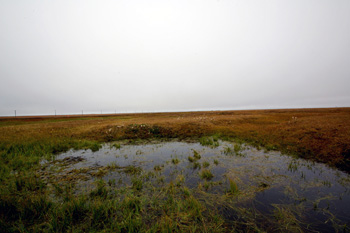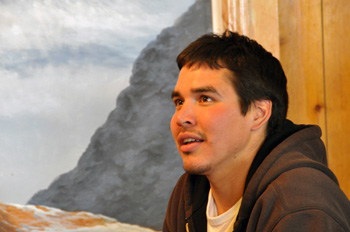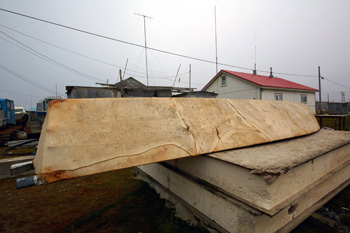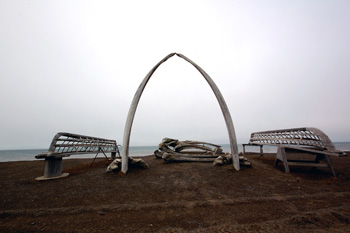September 6th
The hard 25-knot wind riffled the short tundra grass—russet, brown, and gold, early autumn colors—as if it were water. Nok Acker, a jack-of-all-trades for the Barrow Arctic Science Consortium who was showing me around, turned down the truck radio (Jerry Lee Lewis, “Whole Lotta Shakin’ Goin’ On”) pointed out the window and said, “There’s a snowy owl.” The beautiful bird, head swiveling, perched on a low mound, the only prominence in the dead-flat landscape. Still unused to “seeing” in this exotic environment, I would never have spotted the owl. I wondered what else I was missing and regretted that there would be no time to find out. Nok is Athabascan by birth. His people, caribou hunters, live in the Alaskan interior mainly south of the Brooks Range, but he has adopted Barrow, an Inupiaq community as his home. It is barnacled to the beach at the intersection of the Chukchi and Beaufort seas, and at its back this tundra environment stretches southward beyond the imagination. Barrow is an American town. Its residents speak English, pay taxes, and vote in state and federal elections like those in Anytown, U.S.A. Its residents, however, are predominantly Native Americans who maintain and cherish vestiges of their ancient hunting culture—particularly bowhead whale hunting.
It’s not entirely clear when the modern Inupiaq came into the country, but we know that marine-adapted hunter-gatherer cultures were living on the Siberian side of the Bering Sea 18,000 years ago. We know, too, that all ancient human migration into North America crossed the Bering Strait land bridge during the Last Ice Age when sea levels were some 300 feet lower than today. The migration into the Arctic happened in waves, one culture succeeding the other until humans had spread across the Canadian Archipelago and on to Greenland. Arguably, ancestors of the modern Inupiaq arrived on Alaska’s North Slope some 2,000 years ago, fishing and hunting caribou southwest of present Barrow. But something altered their survival strategy; perhaps climate change rerouted caribou migration patterns, but in any case, the people turned to marine mammals, whales and seals, as their main food and clothing sources. Millennia passing, the traditional Inupiaq culture still revolves around the annual whale hunt, and the whaling captains are still pillars of their community. The Prey and the Hunters Bowheads are large whales, slow swimmers, and relatively docile unlike, say, the grey whale. They range in size from about 40 to 60 feet, adults weigh some 120 tons, and their blubber, 17-20 inches, is thicker than any other whale, making them highly desirable quarry. But it is their migration pattern that makes them vulnerable to shore-based hunters in small skin-covered boats. They gather in winter in ice-free areas (“polynynas”) around the Bering Sea, and as winter ebbs, they move northeast into the Chukchi Sea, passing close to Point Barrow in April and early May, heralding the spring hunt.
The chase, the kill, the butchering on the beach—it must be an unforgettable sight. The whalers I spoke with describe the experience with a mix of excitement and reverence. Nok, a member of his wife’s family’s crew, showed us one of the handmade whaleboats. You needn’t know a thing about boats to recognize that this is a brilliant craft, a stout wooden skeleton, about 26 feet long covered with bearded-seal skins stitched together. There’s an old saying about boats: “If it looks good, it is good.” This boat, called an umiak, looks good indeed, with lovely sheer at bow and stern and fine flare amidships. But it must be frightening to approach and try to harpoon an animal the size of a four-storey building weighing well over one hundred tons from a 25-foot skin boat no matter how highly evolved. “Yes, it is dangerous,” said Herman Ashoak, one of Barrow’s most respected captains. “People do get killed.” But he and his people believe that an animal so intelligent and powerful could not be killed without its cooperation. The whale gives up its life for the good of the people, and so the people must demonstrate their respect and gratitude. Whaling Then and Now The issue of whaling is complex from conservational, legal, and from emotional perspectives. Many Westerners are troubled by the killing of these magnificent animals, but we might remind ourselves that we—not Native Americans—very nearly exterminated the whale—and for money not for subsistence survival. The bowhead has been protected by international agreement since 1931, but Arctic people were exempted because they were not commercial whaling. But then in 1977 the National Marine Fisheries Service discovered that no more than 1,800, maybe as few 600 bowheads remained in the Western Arctic. Alarmed, the International Whaling Commission (IWC) rescinded the Inupiaq’s exemption on the grounds that the bowhead population could not withstand any pressure from humans. The North Slope natives were outraged. Here legislators 10,000 miles away who knew nothing about the North were proscribing a way of life far, far older than the United States itself. Not only that, they said, the Fisheries scientists were dead wrong about those numbers—in fact there were many more bowheads in the Western Arctic. The scientists had counted only the whales they could see, but, said the Natives, many more whales spent long periods beneath the ice. So the Inupiaq formed a white-man’s style political organization, the Alaska Eskimo Whaling Commission (AEWC), and they hired their own scientists to lower hydrophones through the ice to record whale calls. Yes, sure enough, there were many more bowheads than the white people had thought. And in 1998, IWC scientists agreed that the Western Arctic bowhead populations could probably sustain a catch of about 100 whales per year.
And now in September as we await the helicopter that will take us out to the Healy, the bowheads are about to begin their eastward, return migration, and the fall hunt to follow. And in fact, Dr. Bob has obtained permission from the AEWC to conduct research in these waters, pledging that the Healy will in no way interrupt the fall migration. As the frequency of at-sea scientific research increased in these waters, the community grew concerned that ships and their noise would interrupt bowhead migration. With their growing political sophistication, the Inupiaq expressed their concerns to the National Science Foundation in no uncertain language. What could have been a protracted legal confrontation was amicably resolved by face-to-face communication and expressions by scientists of genuine respect. Among the upshots of the discussion, scientists agreed to take “community observers” on the expeditions acting as liaisons between scientists and locals. We’re pleased to have as our community observer Elizabeth Rexford, who grew up in Barrow and graduated this year from Dartmouth College with a major in environmental studies. Elizabeth will be writing “An Inupiaq Perspective” for this website, helping us fill some gaps between the scientific and Native approach to understanding nature. But now it’s time to head for the airport to meet the helicopter for the short hop out to Healy (she’s been at anchor about three miles off the beach because the water is too shallow and there is no harbor). I’m not the only member of the science staff who has never been aboard a helicopter, not to mention an icebreaker. And that’s one of the many pleasing aspects to participation in a science-research cruise: You can depend almost always on encountering the exotic, unusual, and often the spectacular. We’ll talk with you soon from aboard the U.S. Coast Guard icebreaker Healy.
Last updated: September 28, 2010 | |||||||||||||||||||||
Copyright ©2007 Woods Hole Oceanographic Institution, All Rights Reserved, Privacy Policy. | |||||||||||||||||||||




